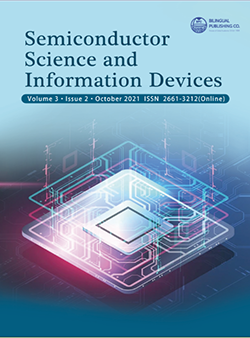Measurement Analysis of Specific Absorption Rate in Human Body Exposed to a Base Station Antenna by Using Finite Difference Time Domain Techniques
DOI:
https://doi.org/10.30564/ssid.v3i2.3861Abstract
The system analysis of specific absorption rate (SAR) in human body exposed to a base station antenna by using finite difference time domain techniques was presented in this research works. The objectives of this work are to evaluate the knowledge and awareness about SAR among human body and mobile base station. The paper investigates the electromagnetic wave absorption inside a human body. The human body has been identified using dataset based on 2D object considering different electrical parameters.The SAR convinced inside the human body model exposed to a radiating base station antenna (BSA) has been considered for multiple numbers of carrier frequencies and input power of 20 W/carrier at GSM 900 band.The distance (R) of human body from BSA is varied in the range of 0.1 m to 5.0 m. For the number of carrier frequency equal to one and R = 0.1 m,the concentrated value of whole-body average SAR obtained by FDTD technique is found to be 0.68 W/kg which decreases either with increase of R or decrease of number of carrier frequencies. Safety distance for general public is found to be 1.5 m for number of carrier frequencies equal to one.The performance accuracy of this analysis meets the high level condition by comparing with the relevant system development in recent time.
Keywords:
Specific Absorption Rate (SAR), Electromagnetic wave, Mobile basic station, Public health safety, RF wavesReferences
[1] Hla Myo Tun, “Radio Network Planning and Optimization for 5G Telecommunication System Based on Physical Constraints”, Journal of Computer Science Research, Volume 03, Issue 01, January 2021.DOI: https://doi.org/10.30564/jcsr.v3i1.2701.
[2] D. Pradhan, P. K. Sahu, A. Dash and Hla Myo Tun,“Sustainability of 5G Green Network toward D2D Communication with RF- Energy Techniques,” 2021 International Conference on Intelligent Technologies (CONIT), 2021, pp. 1-10.DOI: https://doi.org/10.1109/CONIT51480.2021.9498298.
[3] Devasis Pradhan, P.K. Sahu, Rajeswari, Hla Myo Tun, A Study of Localization in 5G Green Network (5G-GN) for Futuristic Cellular Communication, The 3rd International Conference on Communication,Devices and Computing (ICCDC 2021), India, 16-18 August 2021.
[4] Zin Mar Phyo, Tint May Nway, Khin Kyu Kyu Win,Hla Myo Tun. “Development of Microstrip Patch Antenna Design for GPS in Myanmar”. American Journal of Electromagnetics and Applications. Vol. 8,No. 1, 2020, pp. 1-11.DOI: https://doi.org/10.11648/j.ajea.20200801.11.
[5] Hla Myo Tun, Aye Thandar Phyo, “Integrated WiFi/WiMAX Heterogeneous Wireless Network with Minimum Cost Flow Robust Optimization Uncertain Demand Problem”, Bahria University Journal of Information & Communication Technology Vol. 3,Issue 1, pp 16-21, December 2010. Pakistan.
[6] Kundi, M. and H. P. Hutter, “Mobile phone base stations-effects on wellbeing and health,” Pathophysiology, Vol. 16, 123-135, ELSEVIER, Aug. 2009.
[7] Stalling, W., Wireless Communication and Networks,Prentice Hall, 2002.
[8] Kumar, N. and G. Kumar, “Biological effects of cell tower radiation on human body,” International Symposium on Microwave and Optical Technology (ISMOT), Dec. 2009, Available:http://briarcliffheights.org/bch/wp-content/uploads/2011/12/celltowerradiationeffects-100317162351-phpapp01.pdf.
[9] Ali, F., R. R. Sahoo, and S. Ray, “Study of maximum local temperature rise and hotspots distribution in a human head for GSM900 mobile phone,” International Conference on Eco-friendly Computing and Communication Systems (ICECCS), 72{78, Advances in Energy Aware Computing and Communication System, Tata McGraw Hill, India, Oct. 2013, ISBN-13:978-9-35-13432-5.
[10] Lennart, H., “Epidemiological evidence for an association between use of wireless phones and tumor diseases,” Pathophysiology, PATPHY-595, ELSEVIER, 2009.
[11] Blackman, C. F., et al., “Effects of ELF fields on calciumion efflux from brain tissue in vitro,”Radiation Research, Vol. 92, 510-520, 1982.
[12] Lai, H. and N. P. Singh, “Melatonin and a spin-trap compound block radiofrequency electromagnetic radiation-induced DNA strand breaks in rat brain cells,” Bioelectromagnetics, Vol. 18,446-454, 1997.
[13] Kundi, M. and H. Peter, “Mobile phone base stations-effect on wellbeing and health,”Pathophysiology, Vol. 16, 123-135, ELSEVIER, 2009.
[14] ICNIRP, “Guidelines for limiting exposure to timevarying electric, magnetic, and electromagnetic fields (10 kHz to 300 GHz),” Health Physics, Vol. 74, No. 4, 494-522, Apr. 1998.
[15] Council of the European Communities, “Recommendation of 12 July 1999 on the limitation of exposure of general public to electromagnetic fields (0 Hz to 300 GHz),” Official Journal of the European Communities, L.199/59-61, Jul. 30, 1999.
[16] Zin Thu Thu Lin, Hla Myo Tun. “Design and Fabrication of a Planar Inverted-F Antenna (PIFA) for LEO Satellite Application”. American Journal of Electromagnetics and Applications. Vol. 8, No. 1,2020, pp. 28-32.DOI: https://doi.org/10.11648/j.ajea.20200801.14.
[17] Phyo Sandar Win, Hsu Myat Tin Swe, Hla Myo Tun, “Computerized FDTD Method for Longitudinal Optical Phonon Energy on Semiconductor Hybrid Structure for High Power Devices Fabrication”, Journal of Computer Science Research, Volume 03, Issue 02, April 2021.DOI: https://doi.org/10.30564/jcsr.v3i2.3139.
[18] Hla Myo Tun, Thida Than, Myint Myint Than, Khin Sandar Tun, Zaw Min Naing, Maung Maung Latt,Win Khaing Moe. “Analysis on Research and Education for Electromagnetic-Applied Subjects with Finite Difference Time Domain Theory”. American Journal of Electromagnetics and Applications. Vol. 6,No. 1, 2018, pp. 6-16.DOI: https://doi.org/10.11648/j.ajea.20180601.12.
[19] Karwowski, A., “Evaluating exposure to radio-frequency emissions from base station antennas,”13th IEEE International Symposium on Personal,Indoor and Mobile Radio Communications (PIMRC), 1877-1881, Dec. 2002, Available: http://ieeexplore.ieee.org/xpl/login.jsp?tp=&arnumber=1045504&url=http%3A%2F%2Fieeexplore.ieee.org%2Fxpls%2Fabs all.jsp%3Farnumber%3D1045504.
[20] Karwowski, A., “Comparison of simple models for predicting radiofrequency fields in vicinity of base station antennas,” Electronics Letters, Vol. 36, No.10, 859-861, May 2000.
[21] M.A. Mangoud, R.A. Abd-Alhameed and P.S. Excell,Computation Of Specific Absorption Rate In The Human Body Due To Base-Station Antennas Using A Hybrid Formulation, IEEE Transactions on Electromagnetic Compatibility · June 2005.
[22] M. R. Iqbal-Faruque, N. Aisyah-Husni, Md. Ikbal-Hossain, M. Tariqul-Islam and N. Misran, “Effects of Mobile Phone Radiation onto Human Head with Variation of Holding Cheek and Tilt Positions”,Journal of Applied Research and Technology, Volume 12, Issue 5, 2014, Pages 871-876, ISSN 1665-6423.DOI: https://doi.org/10.1016/S1665-6423(14)70593-0.




 Aims and Scope
Aims and Scope Hla Myo Tun
Hla Myo Tun





